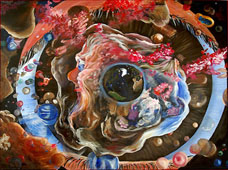 |
| Me and my buddy Sean at the Getty (I'm on the right) |
For my third event, I decided to go to the Getty with some of my friends. The Getty has always interested me, and was one of the places I was told to go to while attending college at UCLA. Last year I could see the Getty from my dorm room, and always wondered what was there. Overall, the Getty was a very cool place to visit, except for the $15 that it cost to park. I would definitely recommend the Getty to art lovers and those who appreciate a good view.
From the time you arrive at the Getty, you are treated with an enjoyable experience. A tram ride along a hillside leads you to the front steps of the Getty, where statues and steps lead you to the inside. The Getty is very big, and it was very overwhelming trying to decide where to go to. The first exhibit I visited was that of Robert Mapplethorpe’s photography. His photography was something that I admired very much, being interested in photography myself. One photo that really caught my eye was his photograph titled “Waves”.
 |
| Waves |
Later on at the Getty, we walked around and viewed the large amount of paintings that the Getty had to offer. One of the paintings that interested me was a painting by Claude Monet titled “Sunrise”. It was very cool to see the artwork in person of famous artists that I had learned about as a child. When I was younger, my school had a class that everyone went through call “Meet the Masters”, where every week we learned about famous artists in-depth, Claude Monet being one of them.
 |
| Me and 'Sunrise' |





























